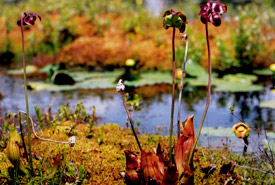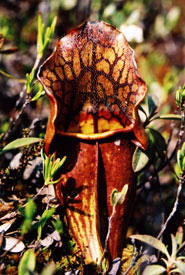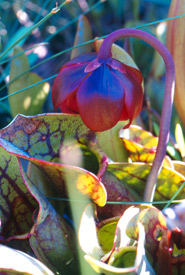
Purple pitcher plant (Photo by Mark Alexander MacDonald)
Pitcher plant
There is only one species of pitcher plant in Canada. The purple pitcher plant, or northern pitcher plant, referred to simply as pitcher plant in Canada, is one of the 18 species of carnivorous plant species in the country.
What does the species look like?
The purple pitcher plant is one of the smaller species in pitcher plant family, growing up to 30 centimetres long. Depending on the location, the species will have deep purple veins running through it. This colouration helps to attract prey such as flies to the plant.

Pitcher plant (Photo by Mark Alexander MacDonald)
The insect-trapping body of the species is leaves that have evolved to be tubular. Rainwater collects within this “pitcher”, into which attracted insects will fall.
Habitat
The pitcher plant can be found in bogs and fens all across Canada. They are native to North America and have adapted to growing in thin, nutrient deficient soils. They absorb nutrients derived from their prey to supplement those lacking in the soil to thrive.
Meat-eater
This species survives off insects that fall into its captivity. In addition to the plant’s appearance, the pitcher plant lures prey with sweet-smelling nectar that emanates from the rim of the pitcher. Once an insect falls into this pitcher, it is almost impossible to get out.
The slippery rim, or peristome, of the pitcher prevent insects from gaining the traction needed to escape. It is also lined with downward-pointing hairs that help trap them. Even flying insects are no match for the pitcher plant. The water within is a pool of sugars and digestive enzymes to dissolve the prey almost immediately.
Provincial icon

Purple pitcher plant (Photo by Helen Jones)
The pitcher plant is Newfoundland and Labrador's Provincial Flower. It was chosen by Queen Victoria more than 100 years ago to be engraved on the Newfoundland and Labrador penny and in 1954 was designated by the province as the official floral emblem.
What is NCC doing to protect habitat for this species?
Across Canada, the Nature Conservancy of Canada (NCC) is conserving wetlands that provide important habitat for pitcher plants.
One project in particular, located on the west coast of Newfoundland, is Grassy Place. This stunning 1,570-hectare (3,879-acre) property is the largest Atlantic project NCC has protect to date. It boasts the most extensive area of native grasslands in the province and is the largest wetland of its type in Newfoundland and Labrador. It is home to various types of flora, including the pitcher plant, and waterfowl populations.




